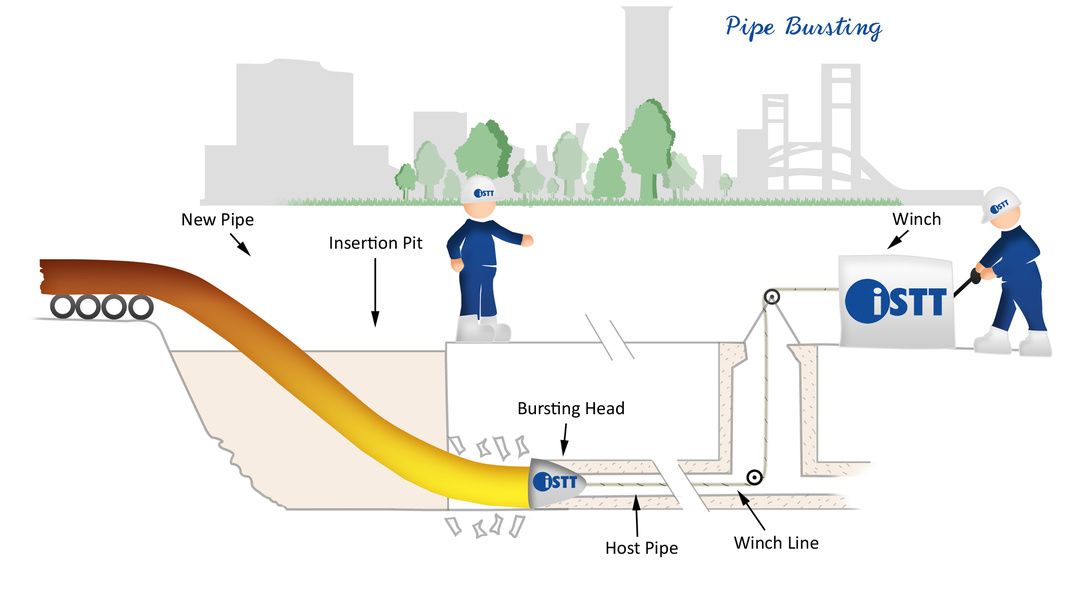Pipe Bursting
Pipe bursting is a trenchless method used to replace existing pipelines in the same alignment without physically removing the existing pipeline. By using the existing alignment to replace a pipe, the need to secure additional right-of-way to install the replacement pipe can be avoided. Bursting can be used to upsize the pipeline increasing its flow capacity. Pipe bursting was initially developed in the 1980s to replace small diameter cast iron gas distribution lines, but has since grown in acceptance as an effective method for replacing pipelines diverse in size, material type, and function including water, sewer, or gas pipelines. Pipe bursting is used to replace brittle pipes such as clay, concrete and cast iron through the application of a static or pneumatic bursting head to fragment the existing pipe.
The pipe bursting process consists of advancing a conical-shaped bursting head that has a diameter 50 to 100 mm larger than the new replacement pipe, through the existing pipe. The radial expansion caused by the geometry of the bursting head fractures the host pipe and displaces the pipe fragments and the ground area surrounding the pipe. Simultaneously, a new product pipe attached to the back of the bursting head is pulled into the space created by the bursting head.

Expander / Hammer Configuration
The typical pipe bursting configuration is termed a rear expander and consists of a nose section that fits within the existing host pipe and with the conical expansion section at the rear of the bursting head. This configuration aids the bursting and replacement process to follow the alignment of the existing pipe. For a static pull, there are no other moving parts. For a pneumatic process, the hammering mechanism fits within the bursting head and may be an integral part of the bursting head. Sometimes, in order to work within small arrival manholes, it is advantageous to use a bursting head with the expansion section at the front of the bursting head and this is termed a “front expander”. If the impact mechanism is kept separate from the bursting head itself, it is possible to remove the front expander in the arrival manhole and retract the impact mechanism to the starting manhole.
Pipe Fracture Mechanism
The original pipe bursting application used for replacement of gas mains in the UK, used a pneumatic hammer pulled through the existing pipe using a cable. In this configuration, the tension in the cable was mainly used to keep the bursting head in good contact with the existing pipe thus relying on the hammering mechanism to fracture the existing cast iron pipes. The cable and pulley configuration, the flexible pneumatic supply line and the small diameter of the PE replacement pipe allowed the work to be accomplished with minimal additional excavation and primarily using existing manholes. As the method was applied to sewer pipes in larger diameters, approaches were introduced relying on a static pull and the conical head to burst existing brittle pipes such as clay pipes and unreinforced concrete pipes. Fins are also used on the bursting head to provide stress concentrations to aid in the fracture process. The static pull could be applied using suitable cable mechanisms or using a segmented rod pull system. Today, both static pull and dynamic methods are widely used and the dynamic methods may use pneumatic or hydraulic impact systems. The choice of system depends on the type of host pipe and backfill, job configuration, equipment availability and contractor preference.
Pneumatic / Hydraulic Hammer
A pneumatic hammer device was the original pipe bursting device used in the UK for replacing gas mains. The hammering of the conical head within the end of the pipe being burst creates the radial expansion forces to fracture the existing pipe. A cable under tension is used to advance the bursting head and keep it in contact with the existing pipe.
Static Pull
Static pull systems for pipe bursting do not include the use of pneumatic hammers to effect the bursting process. The bursting is accomplished using the splitting force created by the pulling of the slanted bursting head into the existing pipe. Cables or quick connect rod systems are used to provide the tensile pull. Splitting may be aided by the use of fins on the face of the bursting head to create stress concentrations in the existing pipe.
Assist Techniques
For many pipe bursting applications in suitable pipes and surrounding ground conditions, the bursting process is fast, simple and effective. When the job conditions are more challenging, there are some assist techniques that can be used to facilitate the pipe bursting and pipe pull-in challenges. To aid in pipe fracture, it is possible to create stress concentration by scoring the existing pipe ahead of the bursting process. For large-diameter long distance pipe bursting applications, the friction on the replacement pipe as it is pulled through the ground can slow and even stop the bursting process. Annular space lubrication, as in microtunneling, may be used but it is also possible to add a pipe ramming device to the rear end of the replacement pipe. It is not considered that the ramming device contributes significantly to the impact or force at the bursting head itself but rather that the longitudinal vibration prevents the replacement pipe from being seized in the surrounding ground.